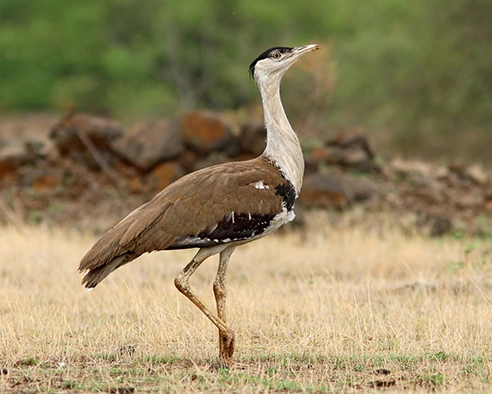Biodiversity & Environment
Great Indian Bustard (GIB)
- 14 Dec 2021
- 5 min read
Why in News
Recently, the Centre has approached the Supreme Court seeking modification of its order directing that all transmission cables in the habitat of the Great Indian Bustard (GIB) be laid underground.
Key Points
- Background:
- Earlier this year (2021), in a bid to check the dwindling numbers of the endangered Great Indian Bustard and Lesser Florican, a Supreme Court bench directed that overhead power lines be laid underground, wherever feasible, passing along the habitat of the birds in Rajasthan and Gujarat.
- Concerns Raised:
- Implications for the Power Sector in India:
- The area falling in Rajasthan and Gujarat contains a large proportion of the country’s total solar and wind energy potential.
- Laying power lines underground will escalate the cost of renewable energy production and hurt India’s renewable energy cause.
- Energy transition is essential for reducing emission and controlling climate change and India has made international commitments including under the agreement signed in Paris in 2015 under the United Nations Framework Convention on Climate Change (UNFCCC) for transition to non-fossil fuels and for emission reduction.
- India has set a target to achieve installed renewable energy capacity (excluding large Hydro) of 175 GW by 2022 and 450 GW by 2030.
- Chances of Renewable Energy to Remain Untapped:
- So far, only a miniscule 3% of the estimated potential of around 263 GW renewable energy in this area has been tapped.
- If the remaining potential stays untapped, an additional 93,000 MW of coal fired capacity will be needed to replace the unutilised renewable energy in the future which would cause an adverse direct impact on the environment.
- Implications for the Power Sector in India:
Great Indian Bustard (GIB)
- About:
- It is the State bird of Rajasthan and is considered India’s most critically endangered bird.
- It is considered the flagship grassland species, representing the health of the grassland ecology.
- Its population is confined mostly to Rajasthan and Gujarat. Small populations occur in Maharashtra, Karnataka and Andhra Pradesh.
- The bird is under constant threats due to collision/electrocution with power transmission lines, hunting (still prevalent in Pakistan), habitat loss and alteration as a result of widespread agricultural expansion, etc.
- Protection Status:
- International Union for Conservation of Nature Red List: Critically Endangered
- Convention on International Trade in Endangered Species of Wild Fauna and Flora (CITES): Appendix 1
- Convention on Migratory Species (CMS): Appendix I
- Wildlife (Protection) Act, 1972: Schedule 1
- Measures taken to protect GIB:
- Species Recovery Programme:
- It is kept under the species recovery programme under the Integrated Development of Wildlife Habitats of the Ministry of Environment, Forests and Climate Change (MoEFCC).
- National Bustard Recovery Plans:
- It is currently being implemented by conservation agencies.
- Conservation Breeding Facility:
- MoEF&CC, Rajasthan government and Wildlife Institute of India (WII) have also established a conservation breeding facility in Desert National Park at Jaisalmer in June 2019.
- The objective of the programme is to build up a captive population of Great Indian Bustards and to release the chicks in the wild for increasing the population.
- Project Great Indian Bustard:
- It has been launched by the Rajasthan government with an aim of constructing breeding enclosures for the species and developing infrastructure to reduce human pressure on its habitats.
- Eco-Friendly Measures:
- Task Force for suggesting eco-friendly measures to mitigate impacts of power transmission lines and other power transmission infrastructures on wildlife including the Great Indian Bustard.
- Species Recovery Programme:





